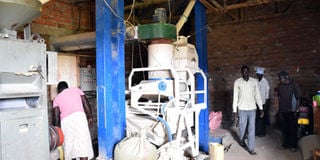Value addition equipment change farmer’s livelihoods

Rice mill for Noteeber farmer's group in Ogana village, Omoro Sub County in Alebtong District. Photo by Charlotte Ninsiima
What you need to know:
- A crusher machine to mill bone meal as an organic fertilizer for their plants and nutritional supplement for the animals. Eric Kihuluka, Chairman of the group asserts, also received a mixer that mixes animal feeds and a pelting machine to reduce wastage of feeds.
- Not only have they embraced vegetable growing but supplemented their income to purchase a soya oil presser that has boosted both cash inflow in terms of soya oil sales and, food plus manure from the soya residuals.
Farmer groups in the East and North rice growing regions confirm to improved livelihoods and sustenance wellbeing after National Agriculture Advisory Services (NAADs) doled out value addition equipment worth Shs8 billion two years ago.
“A kilo of husked rice is cheaper than a kilo of milled rice. Our local variety, Super rice has both a local market and regional market, within East Africa, however, our challenge has been produced. With the implementation of value addition equipment, it means our production will go up, and will be able to produce more than we can actually sell out. Also reduce on imported rice from the outside,” Khadija Nakakande, Head of Communications and Public Relations NAADs Secretariat, asserts.
The focus foods include maize, poultry and rice for food security and income generation. NAADs is supporting farmers with rice mills in order to mill their produce to increase their production and reduce on the long treks in search of mills. Alebtong District known to harbour war returnees found solace in growing rice after getting numerous training from NARO. They were given a number of varieties that they have been growing.
The government spent Shs8 billion on procurement of the value addition equipment. The five rice mills cost Shs198.2 million, 105 maize mills cost Shs55.1million, and 19 feed mills at Shs62million. Plans are underway to distribute more to farmers organized under groups.
During 2014, the mandate of NAADs was refocused to look at the distribution of agricultural inputs mainly focusing on the seeds-planting materials and livestock, there have been efforts to prove the ongoing works.
“Six years down the road, we feel that there is an improvement in production of the commodities supported like bananas, maize and cassava. The increased production came in after the farmers’ outcry to access the market easily so as to avoid wastage and produce from going bad.” Nakakande justifies, cases of matooke ripening, and issues of aflatoxins in the maize and the cassava are no longer severe due to improvised value chain addition.
At Bugiri District Integrated Farmers and Agri-business Association that comprises of 2036 farmers clustered in six sub-counties that include Buhday, Nabukalu, Iwemba, Bulidha, Bukeesa, and Buwung in Bugiri Municipality. Vero Kaudha, marketing officer of the Association says, we grew rice but hardly got market until the machines were introduced which opened a window of opportunities.
“Before the pandemic, we exported rice to Kenya at a cost of Shs4200 per kilo compared to the local market stationed at Shs3000. The citation has expanded the ness to local rice seed distribution and acquired more acreage to increase production for other foods like maize, soya beans, rice and cassava.”
On the on the association is capable of milling 30 tons a week. The machine deselects dust or any other dirt and grades rice in four levels.
However, the lockdown has affected them greatly resorting to storing rice as seed and milled until the storm is overdue to dropped prices of rice at Shs1700 from Shs3000.
Also, most farmers are grappling with high maintenance costs of the machinery, low market access during the crisis and unfair electricity bill policy administered to a group of eight millers on one shared electric meter.
“One can’t operate on power unless they have cleared the total bill of others. This policy refrains us from doing business; that is why it was posed for a year,” one of the Busowa traders and farmers’ cooperative society, speaks out.
In Kaliro district, Mikwano EV Uganda, a 416 member group inclusive of the disabled persons in Izinga village, Namuyiwa Sub County, gained more from the intervention.
A crusher machine to mill bone meal as an organic fertilizer for their plants and nutritional supplement for the animals. Eric Kihuluka, Chairman of the group asserts, also received a mixer that mixes animal feeds and a pelting machine to reduce wastage of feeds.
Not only have they embraced vegetable growing but supplemented their income to purchase a soya oil presser that has boosted both cash inflow in terms of soya oil sales and, food plus manure from the soya residuals.




